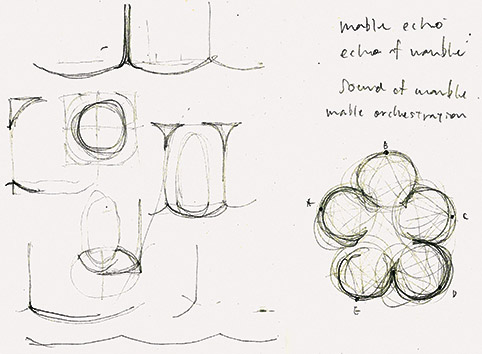Tsuyoshi Tane, archaeologist of the future

Tsuyoshi Tane, Estonian National Museim in Tartu, 2006-2016 (photo: Propaganda)
In the occasion of the next edition of Marmomacc in Verona, Pibamarmi presents the Sound of Marble installation by Tsuyoshi Tane, one of the most intriguing name in new Japanese architecture. The concept of this space is based on the interaction between marble, sound and light, taking its principles from the methodology/manifesto that the architect summarizes in the “Archaeology of the Future” motto. This projecting vision creates a link of continuity among past, present and future in neat opposition to contemporary projects deprived of tradition or memories.
“We begin our work like archaeologists as we start to explore a long distance in time and excavate memories of the place”, Tsuyoshi Tane states. “It is a process of surprise and discovery, of searching to encounter what we didn’t know, what we had forgotten, and what was lost due to modernization and globalization. By this process the memory of the place slowly becomes architecture”. (Tsuyoshi Tane, Archaeology of the Future, Tokyo, TOTO Publishing, 2018).

Tsuyoshi Tane, Horizontal Time installation, Basilea, 2016 (photo: Takuji Shimmura)
Project after project, this archaeological method is continuously renewed looking for historical documents and pictures, evidences of material cultures from the past, ancient work of arts; they become the traces hidden in the layers of a specific place and its history, turning into the conceptual and formal guidelines of new architectural buildings.
Example of this are the great environmental complex of the Estonian National Museum, connected to the airfield of a decommissioned Soviet base; the installations he created in Milano and Basilea for Citizen, taking their shape from the several-century-long speculation of philosophers and scientists on light and its propagation through time and space; or yet again the Todoroki House in Tokyo, clearly recalling archetypes of houses built in forests or wetlands.

Tsuyoshi Tane, Todoroki House in Tokyo, 2017-2018 (photo: Shinkenchiku-Sha)
To Tsuyoshi Tane memory is a fundamental value to face themes like community and resilience, shaping the future with meaningful signs in spite of the volatile identities and ever accelerating information streams of our contemporary age. The Sound of Marble stand as well, created by Tane for Pibamamarm, will follow the same concepts, searching and expressing the hidden stratified essence of an ancient material in a sensorial environment characterized by highly conceptual sounds and lights.

Tsuyoshi Tane, sketches for Sound of Marble stand, 2019
TSUYOSHI TANE: BIOGRAPHY
Born in 1979 in Tokyo, Tsuyoshi Tane is a Japanese architect, founder of the Paris-based Atelier Tsuyoshi Tane Architects. Among his works we can find the Estonian National Museum in Tartu (2006-2016), the House for Oiso in Kanagawa (2014-2015), the Toraya tea room in Paris (2015), the Todoroky House in Tokyo (2017-2018), and the Hirosaki Museum of Contemporary Art (under construction). Tsuyoshi Tane has also participated in several International architectural competitions with projects for the Danish Museum of Natural History in Copenhagen (2009) or the Kofun Stadium in Tokyo (2012). He received several awards such as the French Ministry of Culture Architecture Prize (2007), the French Architects Overseas Grand Prix (2016), and the Japanese Ministry New Face Award (2017). Since 2012 he has been teaching at Columbia University GSAPP.
by Davide Turrini